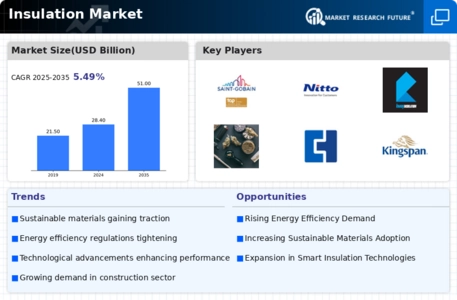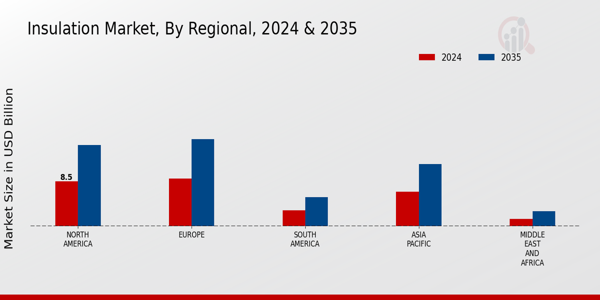Market Analysis
Insulation Market (Global, 2024)
Introduction
The insulation market is poised for significant evolution as it responds to the increasing demand for energy efficiency and sustainable building practices. With a growing emphasis on reducing carbon footprints and enhancing thermal performance in residential, commercial, and industrial applications, the market is witnessing a shift towards innovative materials and technologies. Factors such as stringent building codes, rising energy costs, and heightened consumer awareness regarding environmental impacts are driving the adoption of advanced insulation solutions. Additionally, the integration of smart technologies and the development of eco-friendly materials are reshaping the competitive landscape, presenting both challenges and opportunities for industry players. As stakeholders navigate this dynamic environment, understanding market trends, consumer preferences, and regulatory frameworks will be crucial for strategic decision-making and long-term success.
PESTLE Analysis
- Political
- In 2024, government policies aimed at reducing carbon emissions are influencing the insulation market significantly. For instance, the U.S. government has allocated $1.2 billion for energy efficiency programs, which include incentives for using high-performance insulation materials. Additionally, the European Union has set a target to reduce greenhouse gas emissions by at least 55% by 2030, which is driving demand for insulation products that meet stringent energy efficiency standards.
- Economic
- The insulation market is also affected by economic factors such as inflation rates and construction spending. In 2024, the construction sector in the U.S. is projected to reach $1.8 trillion, with a notable portion dedicated to energy-efficient building projects that require advanced insulation solutions. Furthermore, the average cost of insulation materials has increased by approximately 8% due to rising raw material prices, impacting overall project budgets and consumer choices.
- Social
- Social trends towards sustainability and energy efficiency are shaping consumer preferences in the insulation market. A survey conducted in early 2024 revealed that 72% of homeowners are willing to pay an additional 10% for eco-friendly insulation options. This shift in consumer behavior is prompting manufacturers to innovate and offer more sustainable products, such as those made from recycled materials or natural fibers, to meet the growing demand for environmentally responsible solutions.
- Technological
- Technological advancements are playing a crucial role in the insulation market, particularly with the development of smart insulation materials. In 2024, the market has seen the introduction of phase change materials (PCMs) that can enhance energy efficiency by up to 30% in residential buildings. Additionally, the integration of IoT technology in insulation products allows for real-time monitoring of energy consumption, further driving innovation and adoption in the sector.
- Legal
- Legal regulations regarding building codes and energy efficiency standards are becoming increasingly stringent. In 2024, the International Energy Conservation Code (IECC) mandates that new residential buildings achieve a minimum insulation R-value of 49 in climate zones 5 and above. Compliance with these regulations is essential for manufacturers and builders, as non-compliance can result in fines and project delays, thereby influencing market dynamics.
- Environmental
- Environmental concerns are at the forefront of the insulation market, with a growing emphasis on reducing waste and promoting recycling. In 2024, it is estimated that around 30% of insulation materials used in construction are now made from recycled content, reflecting a shift towards more sustainable practices. Additionally, the industry is facing pressure to minimize the carbon footprint of insulation production, with companies investing in cleaner manufacturing processes to reduce emissions by at least 20% over the next five years.
Porter's Five Forces
- Threat of New Entrants
- Medium - The insulation market in 2024 presents a moderate threat of new entrants. While the industry has established players with significant market share and brand loyalty, the growing demand for energy-efficient solutions and sustainable materials may attract new companies. However, high capital requirements and regulatory compliance can act as barriers to entry.
- Bargaining Power of Suppliers
- Low - Suppliers in the insulation market generally have low bargaining power. The market is characterized by a wide range of raw materials, such as fiberglass, foam, and cellulose, which are sourced from multiple suppliers. This abundance allows manufacturers to switch suppliers easily, reducing the influence of any single supplier on pricing and terms.
- Bargaining Power of Buyers
- High - Buyers in the insulation market hold significant bargaining power due to the availability of numerous options and the increasing focus on cost-effectiveness. With a variety of insulation products available, customers can easily compare prices and features, leading to competitive pricing pressures on manufacturers. Additionally, large-scale buyers, such as construction firms, can negotiate better terms.
- Threat of Substitutes
- Medium - The threat of substitutes in the insulation market is moderate. While traditional insulation materials are widely used, there is a growing trend towards alternative solutions, such as reflective insulation and advanced materials that offer better thermal performance. However, the established nature of traditional insulation products and their proven effectiveness can limit the immediate threat from substitutes.
- Competitive Rivalry
- High - Competitive rivalry in the insulation market is high, driven by numerous players vying for market share. Companies are constantly innovating and improving their product offerings to meet the evolving demands for energy efficiency and sustainability. This intense competition leads to price wars and increased marketing efforts, further heightening the rivalry among existing firms.
SWOT Analysis
Strengths
- Growing demand for energy-efficient building solutions.
- Diverse range of insulation materials available, catering to various applications.
- Strong regulatory support for energy conservation and sustainability initiatives.
Weaknesses
- High initial costs associated with advanced insulation materials.
- Limited awareness among consumers regarding the benefits of insulation.
- Potential supply chain disruptions affecting material availability.
Opportunities
- Increasing investments in green building projects and retrofitting existing structures.
- Technological advancements leading to the development of innovative insulation products.
- Expansion into emerging markets with rising construction activities.
Threats
- Intense competition from alternative building materials.
- Economic fluctuations impacting construction budgets and investments.
- Regulatory changes that may affect material standards and compliance.
Summary
The insulation market in 2024 is characterized by strong demand driven by energy efficiency and sustainability trends, supported by a diverse range of materials and regulatory backing. However, challenges such as high costs and limited consumer awareness may hinder growth. Opportunities lie in the expansion of green building initiatives and technological innovations, while threats from competition and economic uncertainties could impact market dynamics. Strategic focus on education and innovation will be crucial for stakeholders to capitalize on the market potential.















Leave a Comment